Module 4 Healthy food Unit 3 Language in use 课件28张PPT
文档属性
| 名称 | Module 4 Healthy food Unit 3 Language in use 课件28张PPT | 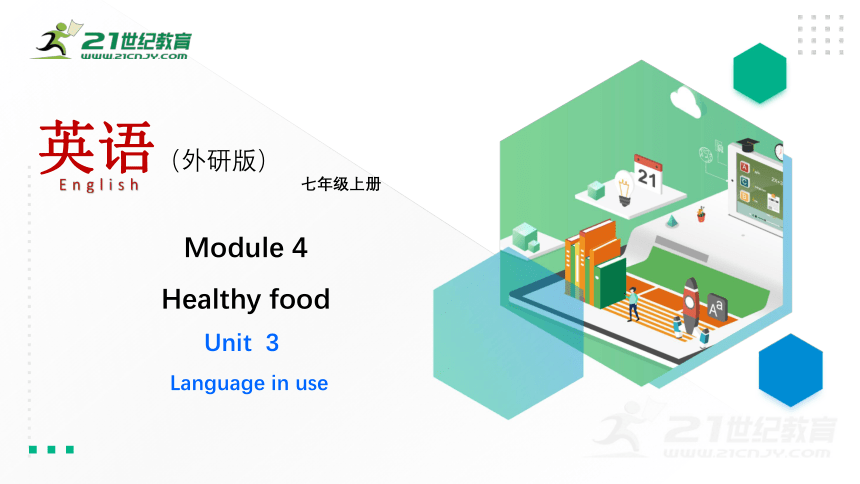 | |
| 格式 | pptx | ||
| 文件大小 | 6.0MB | ||
| 资源类型 | 试卷 | ||
| 版本资源 | 外研版 | ||
| 科目 | 英语 | ||
| 更新时间 | 2021-08-10 08:29:25 | ||
图片预览

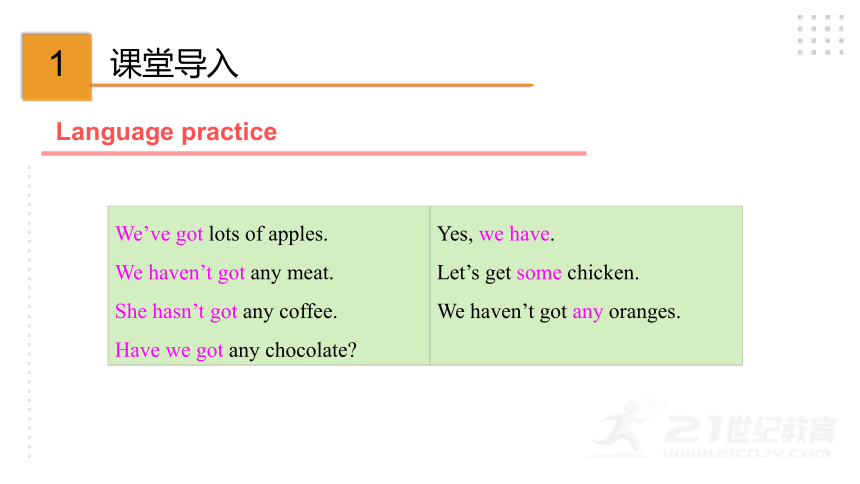

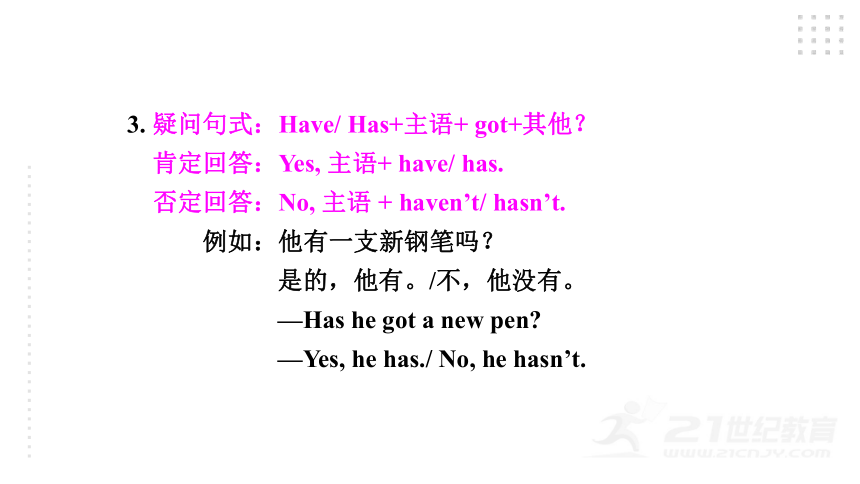
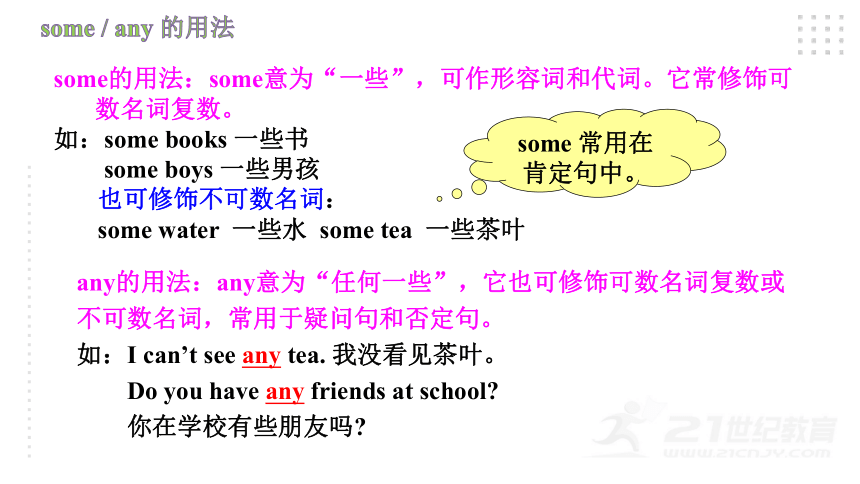
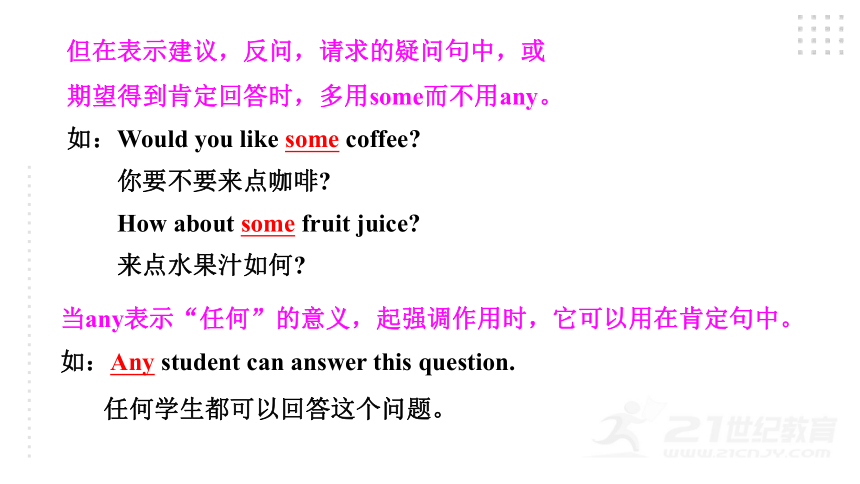
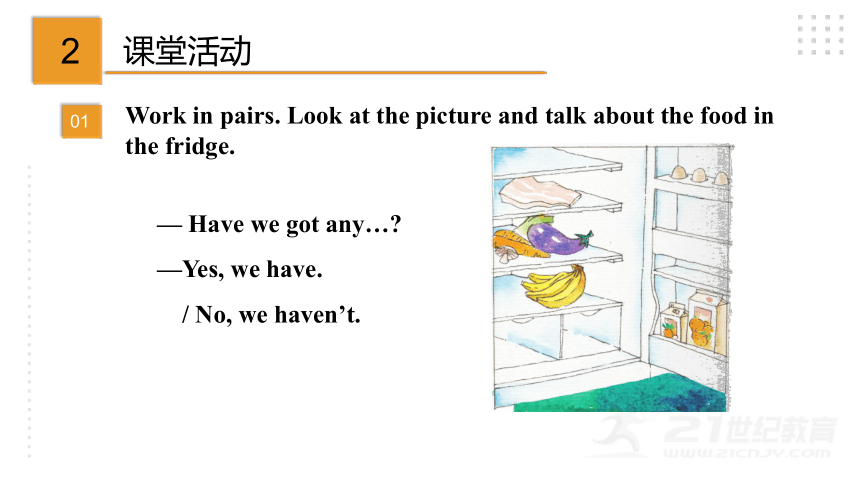
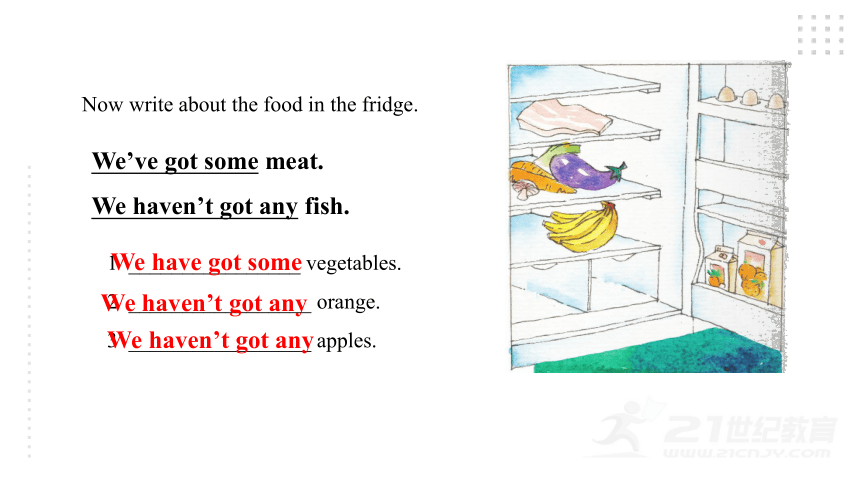
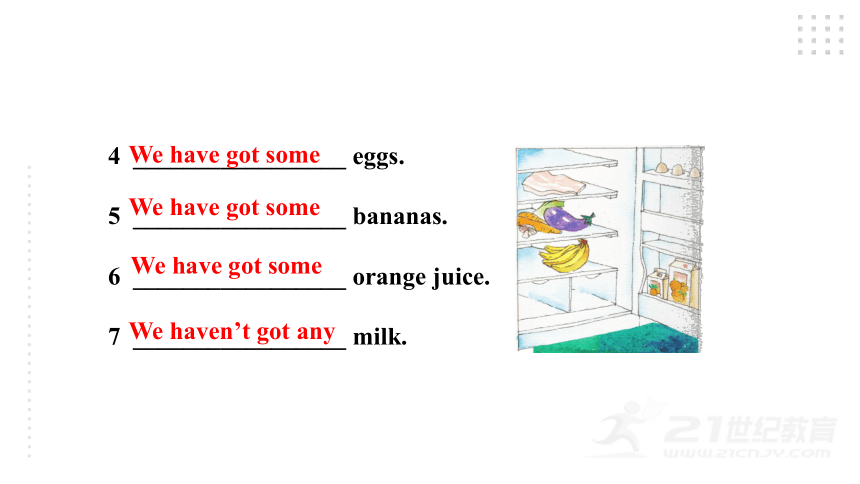
文档简介
英语(外研版)
七年级上册
English
Language in use
Module 4
Healthy food
Unit 3
Language practice
We’ve?got?lots?of?apples.
We?haven’t?got?any?meat.
She?hasn’t?got?any?coffee.
Have?we?got?any?chocolate?
Yes, we?have.
Let’s?get?some?chicken.
We?haven’t?got?any?oranges.
1
课堂导入
主语+ have/ has got+其他. 某人有某人/ 某物
与have/ has got相关的三种句式:
1. 肯定句式:主语+have/ has got +其他.
例如:她的妹妹有一些苹果。
Her sister has got some apples.
have/ has got的用法
2. 否定句式:主语+ have/has+ not+got +其他.
例如:我们没有果汁了。
We haven’t got any juice.
3. 疑问句式:Have/ Has+主语+ got+其他?
肯定回答:Yes, 主语+ have/ has.
否定回答:No, 主语 + haven’t/ hasn’t.
例如:他有一支新钢笔吗?
是的,他有。/不,他没有。
—Has he got a new pen?
—Yes, he has./ No, he hasn’t.
some的用法:some意为“一些”,可作形容词和代词。它常修饰可数名词复数。
如:some books 一些书
some boys 一些男孩
也可修饰不可数名词:
some water 一些水 some tea 一些茶叶
some 常用在肯定句中。
some / any 的用法
any的用法:any意为“任何一些”,它也可修饰可数名词复数或不可数名词,常用于疑问句和否定句。
如:I can’t see any tea. 我没看见茶叶。
Do you have any friends at school?
你在学校有些朋友吗?
但在表示建议,反问,请求的疑问句中,或
期望得到肯定回答时,多用some而不用any。
如:Would you like some coffee?
你要不要来点咖啡?
How about some fruit juice?
来点水果汁如何?
当any表示“任何”的意义,起强调作用时,它可以用在肯定句中。
如:Any student can answer this question.
任何学生都可以回答这个问题。
Work in pairs. Look at the picture and talk about the food in the fridge.
— Have we got any…?
—Yes, we have.
/ No, we haven’t.
2
课堂活动
01
Now write about the food in the fridge.
We’ve got some meat.
We haven’t got any fish.
1 ________________ vegetables.
2 _________________ orange.
3 _________________ apples.
We have got some
We haven’t got any
We haven’t got any
4 _________________ eggs.
5 _________________ bananas.
6 _________________ orange juice.
7 _________________ milk.
We haven’t got any
We have got some
We have got some
We have got some
Look at the picture and talk about it.
apple
hamburger
orange
potato
tomato
apples
hamburgers
oranges
potatoes
tomatoes
02
He has got some / a(n)…
He hasn’t got any…
She has got some / a(n)…
She hasn’t got any…
They have got some / a(n)…
They haven’t got any…
可数名词
表示可以计算数目的人或物的名词称为可数名词。可数名词有单数和复数两种形态。单数可数名词前一般要用不定冠词a/an。可数名词可与具体数词连用,可用many, a few, few, some, a lot of, lots of, plenty of修饰。对可数名词的数量提问用how many。
(1)名词复数的规则变化:
① 一般情况下在词尾加-s。如:
book → books, chair → chairs
② 以s, x, sh, ch结尾的名词,在词尾加-es。如:
class → classes, box → boxes
③ 以f或fe结尾的名词,先将f或fe变为v,再加-es。如:
shelf → shelves, wife → wives
④ 以o结尾的名词,词尾加-es或-s。如:
tomato → tomatoes, photo → photos
⑤ 以辅音字母加y结尾的名词,先将y改为i,再加-es。如:
baby → babies, factory → factories
⑥ 以元音字母加y结尾的名词,词尾加-s。如:
day → days, boy → boys
⑦ 以th结尾的名词,词尾加-s。如:
mouth → mouths, month → months
(2)名词复数的不规则变化:
① 元音字母发生变化。如:
man → men, woman → women, foot → feet,
tooth → teeth, mouse → mice, goose → geese
② 单、复数形式相同。如:
deer, fish, sheep, Chinese, Japanese
③ 词尾发生变化。如:
child → children
④ 有些名词只有复数形式。如:
clothes, trousers, people
⑤ man, woman修饰其他名词时,单复数要与被修饰的名
词保持一致。如:
a man doctor → men doctors
表示不能计算数目的人或物的名词,称为不可数名词。它们前面不能用不定冠词a/an,没有复数形式。不可与具体数词连用。可用much, a little, little, some, a lot of, lots of, plenty of修饰。对不可数名词的数量提问用how much。
当表示不可数名词的确切数量时,通常在不可数名词前加上“数词+单位名词+of”表示。整个词组的单、复数由单位名词的单、复数决定。如:
a piece of paper 一张纸 two pieces of paper 两张纸
A cup of tea is on the table. 一杯茶在桌上。
Three cups of tea are on the table. 三杯茶在桌上。
不可数名词
1) 物质名词是指表示无法分为个体的实物的词, 常见的物质名词, 如:snow(雪), rain(雨), water(水), coffee(咖啡), tea(茶), meat (肉), milk(牛奶), rice(米饭), bread(面包), orange (桔汁), beef (牛肉), chicken(鸡肉), juice (果汁), pork(猪肉), Coke (可口可乐), ice cream (冰激凌) 等;
2) 抽象名词是指表示动作、状态、品质、感情等抽象概念的词,常见的抽象名词,如:work(工作), study(学习), love(爱), friendship (友谊)等。
Complete the word map.
vegetables
fruit
healthy
food
favourite
food
food
healthy
drink
favourite
drink
meat
drink
carrots
tomatoes
bananas
apples
oranges
ice cream
beef
juice
water
milk
milk
beef
chicken
fish
potatoes
tea
03
Complete the sentences with the correct form of the words from the box.
bit delicious important remember stay
1 ___________ to buy some fruit.
2 It’s _____________ to eat healthy food.
3 Eat well and _______ healthy.
4 Orange juice is __________. Let’s buy some.
5 I am a ______ tired.
Remember
important
stay
delicious
bit
04
In the West, for breakfast, people usually eat bread and eggs and drink coffee or tea, milk and fruit juice.
A Western breakfast
Around the world
Module task: Making a poster about a healthy breakfast
Work in groups of four or five. Make a poster about a healthy breakfast.
Make a list of questions about a healthy breakfast.
Talk to students from another group about a healthy breakfast.
Make a poster about your healthy breakfast.
05
Present your poster to the class.
Choose the best poster.
Healthy food
________________
________________
can eat
_________
_________
can’t eat
_________
_________
06
07
3
课堂小结
1.We have learnt how to the structure “have (has)got”.
2. We have learnt to use uncountable nouns, singular and plural nouns
1. 健康食品
2. 最喜欢的饮料
3. 一些西红柿
4. 中国茶
5. 一些橘汁
healthy food
favourite drink
some tomatoes
Chinese tea
some orange juice
一、翻译下列短语。
4
课堂训练
二、用所给单词的适当形式填空。
1. They have got lots of _____ (juice) in the fridge.
2. These ______ (ruler) are Jack’s.
3. He often tells us some ______ (story).
4. What is _____ (you) favourite drink?
5. Jim ___ (have) lunch at school.
6. I like ______ (eat) ice cream.
7. I have two ________ (potato) for breakfast.
juice
rulers
stories
your
has
eating
potatoes
1. We ____ ___ three new students today.
2. Kate’s mother ___ ___ a red dress.
3. _______ a clock on the wall in Jim’s bedroom.
4. ________ some flowers on the teacher’s desk.
5. ________ your sister _______ a nice bike?
三、用 there be / have (has) got / has (have) 的正确形式填空。
have got
has got
There’s
There’re
Has/Does got/have
food:
________________________
________________________
2. drink: __________________
3. vegetable: _______________
4. fruit: ___________________
四、将下面的单词按要求分类,是可数名词的将其变为复数形式。
hamburger, Coke, orange, beef, carrot, chicken, milk, candy, pork, tomato
beef, chicken, pork,
candy/candies, hamburgers
milk, Coke
carrots, tomatoes
oranges
https://www.21cnjy.com/help/help_extract.php
七年级上册
English
Language in use
Module 4
Healthy food
Unit 3
Language practice
We’ve?got?lots?of?apples.
We?haven’t?got?any?meat.
She?hasn’t?got?any?coffee.
Have?we?got?any?chocolate?
Yes, we?have.
Let’s?get?some?chicken.
We?haven’t?got?any?oranges.
1
课堂导入
主语+ have/ has got+其他. 某人有某人/ 某物
与have/ has got相关的三种句式:
1. 肯定句式:主语+have/ has got +其他.
例如:她的妹妹有一些苹果。
Her sister has got some apples.
have/ has got的用法
2. 否定句式:主语+ have/has+ not+got +其他.
例如:我们没有果汁了。
We haven’t got any juice.
3. 疑问句式:Have/ Has+主语+ got+其他?
肯定回答:Yes, 主语+ have/ has.
否定回答:No, 主语 + haven’t/ hasn’t.
例如:他有一支新钢笔吗?
是的,他有。/不,他没有。
—Has he got a new pen?
—Yes, he has./ No, he hasn’t.
some的用法:some意为“一些”,可作形容词和代词。它常修饰可数名词复数。
如:some books 一些书
some boys 一些男孩
也可修饰不可数名词:
some water 一些水 some tea 一些茶叶
some 常用在肯定句中。
some / any 的用法
any的用法:any意为“任何一些”,它也可修饰可数名词复数或不可数名词,常用于疑问句和否定句。
如:I can’t see any tea. 我没看见茶叶。
Do you have any friends at school?
你在学校有些朋友吗?
但在表示建议,反问,请求的疑问句中,或
期望得到肯定回答时,多用some而不用any。
如:Would you like some coffee?
你要不要来点咖啡?
How about some fruit juice?
来点水果汁如何?
当any表示“任何”的意义,起强调作用时,它可以用在肯定句中。
如:Any student can answer this question.
任何学生都可以回答这个问题。
Work in pairs. Look at the picture and talk about the food in the fridge.
— Have we got any…?
—Yes, we have.
/ No, we haven’t.
2
课堂活动
01
Now write about the food in the fridge.
We’ve got some meat.
We haven’t got any fish.
1 ________________ vegetables.
2 _________________ orange.
3 _________________ apples.
We have got some
We haven’t got any
We haven’t got any
4 _________________ eggs.
5 _________________ bananas.
6 _________________ orange juice.
7 _________________ milk.
We haven’t got any
We have got some
We have got some
We have got some
Look at the picture and talk about it.
apple
hamburger
orange
potato
tomato
apples
hamburgers
oranges
potatoes
tomatoes
02
He has got some / a(n)…
He hasn’t got any…
She has got some / a(n)…
She hasn’t got any…
They have got some / a(n)…
They haven’t got any…
可数名词
表示可以计算数目的人或物的名词称为可数名词。可数名词有单数和复数两种形态。单数可数名词前一般要用不定冠词a/an。可数名词可与具体数词连用,可用many, a few, few, some, a lot of, lots of, plenty of修饰。对可数名词的数量提问用how many。
(1)名词复数的规则变化:
① 一般情况下在词尾加-s。如:
book → books, chair → chairs
② 以s, x, sh, ch结尾的名词,在词尾加-es。如:
class → classes, box → boxes
③ 以f或fe结尾的名词,先将f或fe变为v,再加-es。如:
shelf → shelves, wife → wives
④ 以o结尾的名词,词尾加-es或-s。如:
tomato → tomatoes, photo → photos
⑤ 以辅音字母加y结尾的名词,先将y改为i,再加-es。如:
baby → babies, factory → factories
⑥ 以元音字母加y结尾的名词,词尾加-s。如:
day → days, boy → boys
⑦ 以th结尾的名词,词尾加-s。如:
mouth → mouths, month → months
(2)名词复数的不规则变化:
① 元音字母发生变化。如:
man → men, woman → women, foot → feet,
tooth → teeth, mouse → mice, goose → geese
② 单、复数形式相同。如:
deer, fish, sheep, Chinese, Japanese
③ 词尾发生变化。如:
child → children
④ 有些名词只有复数形式。如:
clothes, trousers, people
⑤ man, woman修饰其他名词时,单复数要与被修饰的名
词保持一致。如:
a man doctor → men doctors
表示不能计算数目的人或物的名词,称为不可数名词。它们前面不能用不定冠词a/an,没有复数形式。不可与具体数词连用。可用much, a little, little, some, a lot of, lots of, plenty of修饰。对不可数名词的数量提问用how much。
当表示不可数名词的确切数量时,通常在不可数名词前加上“数词+单位名词+of”表示。整个词组的单、复数由单位名词的单、复数决定。如:
a piece of paper 一张纸 two pieces of paper 两张纸
A cup of tea is on the table. 一杯茶在桌上。
Three cups of tea are on the table. 三杯茶在桌上。
不可数名词
1) 物质名词是指表示无法分为个体的实物的词, 常见的物质名词, 如:snow(雪), rain(雨), water(水), coffee(咖啡), tea(茶), meat (肉), milk(牛奶), rice(米饭), bread(面包), orange (桔汁), beef (牛肉), chicken(鸡肉), juice (果汁), pork(猪肉), Coke (可口可乐), ice cream (冰激凌) 等;
2) 抽象名词是指表示动作、状态、品质、感情等抽象概念的词,常见的抽象名词,如:work(工作), study(学习), love(爱), friendship (友谊)等。
Complete the word map.
vegetables
fruit
healthy
food
favourite
food
food
healthy
drink
favourite
drink
meat
drink
carrots
tomatoes
bananas
apples
oranges
ice cream
beef
juice
water
milk
milk
beef
chicken
fish
potatoes
tea
03
Complete the sentences with the correct form of the words from the box.
bit delicious important remember stay
1 ___________ to buy some fruit.
2 It’s _____________ to eat healthy food.
3 Eat well and _______ healthy.
4 Orange juice is __________. Let’s buy some.
5 I am a ______ tired.
Remember
important
stay
delicious
bit
04
In the West, for breakfast, people usually eat bread and eggs and drink coffee or tea, milk and fruit juice.
A Western breakfast
Around the world
Module task: Making a poster about a healthy breakfast
Work in groups of four or five. Make a poster about a healthy breakfast.
Make a list of questions about a healthy breakfast.
Talk to students from another group about a healthy breakfast.
Make a poster about your healthy breakfast.
05
Present your poster to the class.
Choose the best poster.
Healthy food
________________
________________
can eat
_________
_________
can’t eat
_________
_________
06
07
3
课堂小结
1.We have learnt how to the structure “have (has)got”.
2. We have learnt to use uncountable nouns, singular and plural nouns
1. 健康食品
2. 最喜欢的饮料
3. 一些西红柿
4. 中国茶
5. 一些橘汁
healthy food
favourite drink
some tomatoes
Chinese tea
some orange juice
一、翻译下列短语。
4
课堂训练
二、用所给单词的适当形式填空。
1. They have got lots of _____ (juice) in the fridge.
2. These ______ (ruler) are Jack’s.
3. He often tells us some ______ (story).
4. What is _____ (you) favourite drink?
5. Jim ___ (have) lunch at school.
6. I like ______ (eat) ice cream.
7. I have two ________ (potato) for breakfast.
juice
rulers
stories
your
has
eating
potatoes
1. We ____ ___ three new students today.
2. Kate’s mother ___ ___ a red dress.
3. _______ a clock on the wall in Jim’s bedroom.
4. ________ some flowers on the teacher’s desk.
5. ________ your sister _______ a nice bike?
三、用 there be / have (has) got / has (have) 的正确形式填空。
have got
has got
There’s
There’re
Has/Does got/have
food:
________________________
________________________
2. drink: __________________
3. vegetable: _______________
4. fruit: ___________________
四、将下面的单词按要求分类,是可数名词的将其变为复数形式。
hamburger, Coke, orange, beef, carrot, chicken, milk, candy, pork, tomato
beef, chicken, pork,
candy/candies, hamburgers
milk, Coke
carrots, tomatoes
oranges
https://www.21cnjy.com/help/help_extract.php
同课章节目录
- Starte
- Module 1 My teacher and my friends
- Module 2 My English lesson
- Module 3 My English book
- Module 4 My everyday life
- Module 1 My classmates
- Unit 1 Nice to meet you.
- Unit 2 I'm Wang Lingling and I'm thirteen years ol
- Unit 3 Language in use.
- Module 2 My family
- Unit 1 Is this your mum?
- Unit 2 These are my parents.
- Unit 3 Language in use.
- Module 3 My school
- Unit 1 There are thirty students in my class.
- Unit 2 The library is on the left of the playgroun
- Unit 3 Language in use.
- Module 4 Healthy food
- Unit 1 We've got lots of apples.
- Unit 2 Is your food and drink healthy?
- Unit 3 Language in use.
- Module 5 My school day
- Unit 1 I love history.
- Unit 2 We start work at nine o'clock.
- Unit 3 Language in use.
- Revision module A
- Module 6 A trip to the zoo
- Unit 1 Does it eat meat?
- Unit 2 The tiger lives in Asia.
- Unit 3 Language in use.
- Module 7 Computers
- Unit 1 How do I write my homework on the computer?
- Unit 2 When do you use a computer?
- Unit 3 Language in use.
- Module 8 Choosing presents
- Unit 1 I always like birthday parties.
- Unit 2 She often goes to concerts.
- Unit 3 Language in use.
- Module 9 People and places
- Unit 1 We're enjoying the school trip a lot.
- Unit 2 They're waiting for buses or trains.
- Unit 3 Language in use.
- Module 10 Spring Festival
- Unit 1 Are you getting ready for Spring Festival?
- Unit 2 My mother's cleaning our houses and sweepin
- Unit 3 Language in use.
- Revision module B
